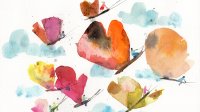Fostering Identity, Joy, and Skill Development
How a teacher used a mini-unit featuring poetry, music, and art to help her third-grade students learn more about themselves and each other.
Your content has been saved!
Go to My Saved Content.“It is our job as educators to not just teach skills, but also to teach students to know, validate, and celebrate who they are.”—Dr. Gholdy Muhammad, Cultivating Genius
The “Historically Responsive Literacy Framework” from Dr. Gholdy Muhammad’s Cultivating Genius is a powerful planning and reflection tool. At my school we call it “The Genius Framework,” which supports our belief that every student has genius. The tool includes five goals: Identity, Skill Development, Intellectualism, Criticality, and Joy. I used the framework to write a mini-unit on Identity, Joy, and Skill for a third-grade class.
Identity, Joy, and Skill
I’m a language and literacy equity coach, so I spent time prior to the unit building relationships with the students during literacy and art. I also asked students to complete a brief interest questionnaire:
- Below, write or draw about interests you have.
- Is there anything you want me to know about you?
Day one began with building consensus around agreements, to build trust:
- Be aware of who I am and what I like.
- Express myself, what I feel and like.
- Accept everyone. We are all unique.
- Treat everyone with respect.
Skill
I explained how the mini-unit builds off the skills (or standards) that students learned in a recent Character Studies unit and the project they created with our art teacher, where, inspired by the Kelsey Montague artwork depicting wings, What Lifts You?, every person in our school made a feather that included their identity and interests. Next, I read The Day You Begin, stopping four times for students to gesture, turn and talk, or respond to open-ended questions about character traits.
I selected this text because it highlights the strength of multilingualism, which is especially important in a class with four multilingual students. To shift to students’ thinking about their own character traits, I listed interests from the questionnaire, connecting them to specific traits. It’s important to provide opportunities for effective oracy, so established, trusting dyads discussed one of the following:
- What you appreciate about yourself
- When you felt proud learning or doing something difficult
- When you felt courageous
I introduced structured talk stems for responding to each other:
- You talked about _____. That showed _____.
Then, students wrote about their own traits. We concluded by having a closing circle where each student shared one thought:
- I am _____.
- I feel _____.
- I learned _____.
- A question I have is _____.
One student said, “I feel excited to be learning more about myself,” while another noted, “I learned that identity can be what you see and what is inside.”
Identity
Day two focused on the goal of Identity, while we continued exploring Skill. I responded to the feedback from the exit tickets (what they learned and questions they had) to build trust and relationships, and to model my learning and reflection. Then, I asked students what they knew about identity, and we developed a common definition:
- Who you are
- The way you think about yourself
- How you would describe yourself to someone who doesn’t know you
- Has multiple parts
- How you are as a learner
- Helps know self and others
- Could include name, language, family, gender, race, religion, ability, etc.
Students added to their trait writing with additional words to describe their identities, both visible and internal. A video of The Reflection in Me introduced examples of visible and internal traits. We also explored how each student felt a sense of belonging and joy. Then, students again wrote exit tickets.
Joy
Day three opened with a Spark (an idea that comes from Zaretta Hammond), and students listened to, and read, lyrics from “What Else Can I Do?” I selected the music and other texts to instill a sense of joy in the students. I gave the meanings of several new words; then we deconstructed the lyrics to infer traits using text evidence. I introduced a broader definition of “text,” including video, lyrics, images, picture books, and poems.
A key practice of the Genius Framework is to use layered, multimodal texts. We listened to Charles R. Smith Jr. read his poem “Allow Me to Introduce Myself,” from the book Hip Hop Speaks to Children. Then students continued deconstructing texts in partnerships, choosing “What Else Can I Do?” or “Allow Me to Introduce Myself.”
Day three ended with brainstorming ideas for our Identity Showcase Project. The art teacher and I provided time and coaching during Art Studio for students to work on their projects. The final projects included a variety of creative ideas: fingerprint, self-portrait, Venn diagram of self and friend, wooden heart, wooden frame. In the future I would also provide the apps GarageBand and WordFoto.
Day four was a final project celebration—it still gives me goosebumps when I remember the day because of the sense of joy. I displayed the projects with fancy backgrounds in a gallery space. Students entered to music playing and viewed the artwork. Partners shared something new they had learned about each other’s identity. In our closing circle I read a Change Sings excerpt to connect Identity to leadership and hope. Then each student shared with the class their answer to the question “What gives you joy?” or “What do you want to share from your Identity project?”
This unit taught us all a great deal. I knew work around Identity and Joy was important for students to understand themselves and to nurture their awareness of the richness of our differences. However, I had no idea of the depth of the positive impact that a four-day unit would have on students. Their understanding of self and acceptance of self surpassed my highest expectations.
